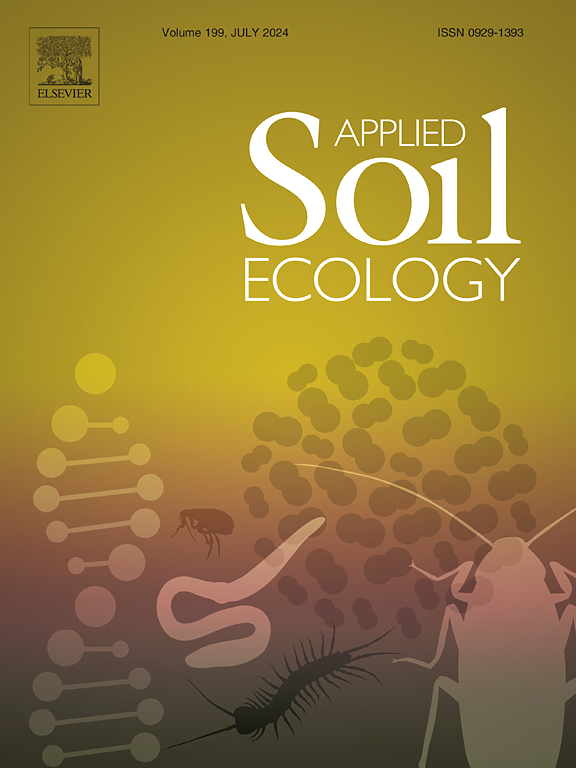干旱和枯落物类型对沙漠-绿洲生态区枯落物分解的影响
IF 4.8
2区 农林科学
Q1 SOIL SCIENCE
引用次数: 0
摘要
植物废弃物是土壤肥力和土壤有机碳库的重要来源,其分解过程受气候条件和废弃物本身质量的影响很大。来自同一植物不同器官的枯落物往往表现出不同的质量特征。然而,有关荒漠生态系统中枯落物分解如何应对干旱和不同植物器官的信息相对较少。在本研究中,我们通过对两种沙漠植物(Suaeda salsa 和 Nitraria tangutorum)不同器官(根、茎、叶)的枯落物进行分解实验(持续 360 天),分析了在不同干旱条件下枯落物的输入对土壤化学计量特性、酶活性和微生物群落结构的影响(重力土壤湿度 W1:7.1%;W2:4.1%;W3:1.8%)。结果表明(i) 荒漠生态系统中不同干旱梯度的枯落物质量损失没有明显差异。枯落物的初始化学特征(尤其是磷)和枯落物器官的类型是影响枯落物分解的主要因素。(ii) 凋落物的混合(相同器官的混合)并不促进分解,但增加了氮的损失(p <0.05),干旱抑制了氮的损失;凋落物的混合还提高了土壤养分的有效性。(iii) 凋落物分解增加了土壤养分和酶的活性,改善了土壤养分状况,缓解了土壤中氮和磷的限制。(iv) 干旱和枯落物器官都是影响土壤微生物群落结构的因素,但不同类型的枯落物器官是造成土壤微生物群落组成差异的主要原因,对真菌群落的影响大于细菌群落。在根屑处理过的土壤中,真菌群落主要由子囊菌(相对丰度为 99%)组成,而叶屑和茎屑则以子囊菌(相对丰度为 56.1-98.7%)和担子菌(相对丰度为 0.8-43.9%)为主。这些结果表明,在沙漠生态系统中,枯落物主要通过其自身的养分含量和器官影响土壤养分循环。本文章由计算机程序翻译,如有差异,请以英文原文为准。
Effects of drought and litter types on litter decomposition in desert-oasis ecotone
Plant litter is a crucial source for soil fertility and the soil organic carbon pool, with its decomposition process significantly influenced by both climate conditions and the quality of the litter itself. Litter from different organs of the same plant often exhibits varying quality traits. However, information on how litter decomposition responds to drought and various plant organs within desert ecosystems is relatively scarce. In this study, we analyzed the impacts of litter input on soil stoichiometric characteristics, enzyme activity, and microbial community structure under different drought conditions through decomposition experiments (lasting 360 days) of litter from two types of desert plants (Suaeda salsa and Nitraria tangutorum) with various organs (root, stem, leaf), subjected to three levels of natural drought (gravimetric soil moisture at W1: 7.1 %, W2: 4.1 %, W3: 1.8 %). The results indicate that: (i) There are no significant differences in the mass loss of litter across the drought gradients in desert ecosystem. The initial chemical characteristics of litter (especially phosphorus) and the types of litter organs are the main factors influencing litter decomposition. (ii) The mixing of litter (mixing of identical organs) did not promote decomposition but increased nitrogen loss (p < 0.05), which was suppressed by aridity; mixing of litter also enhanced the effectiveness of soil nutrients. (iii) Litter decomposition increased soil nutrients and enzyme activity, improved soil nutrient conditions, and alleviated nitrogen and phosphorus limitations in the soil. (iv) Both aridity and litter organs are factors influencing the structure of soil microbial communities, but the different types of litter organs are the primary reason for differences in soil microbial community composition, with a greater impact on fungal communities than on bacterial ones. In soil treated with root litter, the fungal community was predominantly composed of Ascomycetes (relative abundance >99 %), while the leaf and stem litters were dominated by Ascomycetes (relative abundance 56.1–98.7 %) and Basidiomycetes (relative abundance 0.8–43.9 %). These results suggest that in desert ecosystems, litter primarily influences soil nutrient cycling through its own nutrient content and organs.
求助全文
通过发布文献求助,成功后即可免费获取论文全文。
去求助
来源期刊

Applied Soil Ecology
农林科学-土壤科学
CiteScore
9.70
自引率
4.20%
发文量
363
审稿时长
5.3 months
期刊介绍:
Applied Soil Ecology addresses the role of soil organisms and their interactions in relation to: sustainability and productivity, nutrient cycling and other soil processes, the maintenance of soil functions, the impact of human activities on soil ecosystems and bio(techno)logical control of soil-inhabiting pests, diseases and weeds.
 求助内容:
求助内容: 应助结果提醒方式:
应助结果提醒方式:


